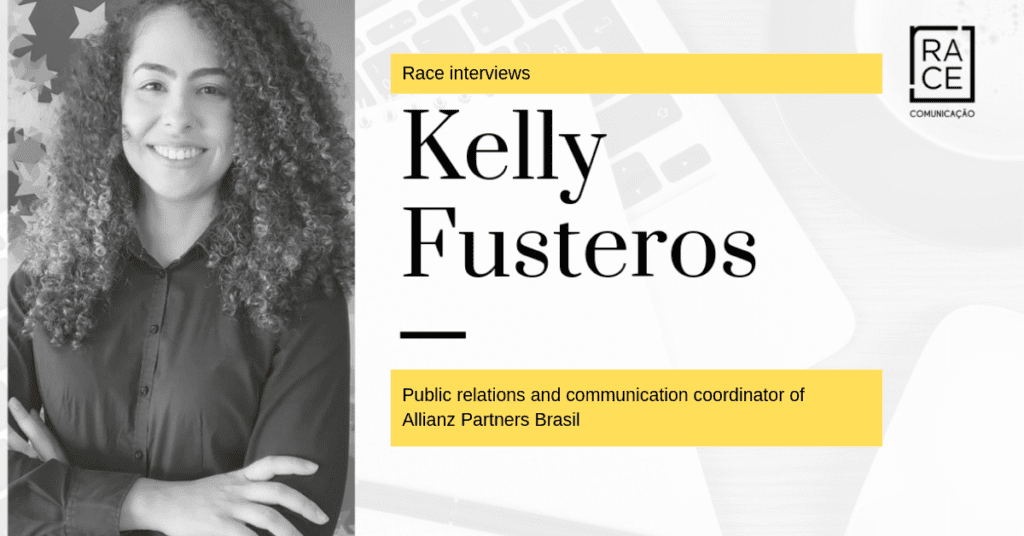The internal communication is a department planned and with scopes determined so that there is the interaction between the company and its collaborators. With it, one can enhance relationships and increase productivity, engagement, and even an organization’s financial outcome.
And so, today’s post brings an exclusive interview with the public relations and communication coordinator of Allianz Partners Brasil, Kelly Fusteros. With more than eight years of professional experience, Kelly followed the changes in the behavior of the companies, mainly the concern for the well-being and the good fellowship of the collaborators.
‘Internal communication plays an important role in companies that cherish a pleasant professional environment.’
In this interview, you will understand the important role of internal communication in companies. Check it out!
Race Communication: How important is internal communication to the company?
Kelly Fusteros: Every organization is made up of people and they are the ones who, working together, will lead the company to achieve its goals and results. The first objective of the Internal Communication is to inform employees about what happens in the company and offer content that can be added in daily activities. Secondly, internal communication has the power to act in the organizational culture, in the dissemination of goals and objectives, and in the engagement of employees.
Internal communication, when it acts strategically close to the board, goes beyond the limits of just carrying information. It engages the collaborator, making them feel part of a “family”, of something more, of seeing meaning in his activities, of linking them with goals, to the point of transforming them into an internal influencer and ambassador of the brand. Internal communication takes transparency, passes a single speech and must always be two-way, that is, senior management for employees and vice versa, thus helping to mitigate false rumors and news within the organization.
RC: How to think about strategic campaigns for this audience? KF: Firstly, it is important to know employees by analyzing quantitative data (number of employees, percentage of men and women, age, region of residence, turnover, percentage of employees in the administrative area and operational area, among others) and qualitative information (annual survey, active listening in corridors or cafeterias, discussion groups, visits to the different areas, meeting with focal points, etc.). With this information, professionals in the area of Internal Communication can draw a profile of employees and what should be the approach: if employees are younger, communication channels and proposed actions may use a more easygoing language, light, with visual that is closer to what this public consumes externally, such as memes and videos; if the employees are from the legal area, for example, it is important to know the terminologies and processes; if the turnover is high, it is necessary to frequently work on the key messages, because the turnover of people impacts the culture and engagement.
One tip is to create a persona, which is the simplified representation of your collaborators, a character who will help communication to better understand who the collaborator is and what he needs.
From these points, the Internal Communication must base its planning on the company’s goals and objectives and on how to transmit this information to the persona in an effective way, considering its characteristics and desires, and engaging it so that employees and company walk in a same direction.
RC: Do you believe that organizations make correct use of internal communication to improve the relationship between employees?
KF: Nowadays, I believe that companies are using internal communication to create a relationship and establish an affective link and interactions between the employer brand and employees.
Among different areas, internal communication can help to break the silos, promoting actions and campaigns of interaction and collaboration, such as a magazine or internal newspaper, in which collaborators interview and create content from other departments; sporting championships; race groups; singing or theater classes; voluntary actions; etc.
RC: Why did the culture of adoption of internal communication campaigns take time to be incorporated by medium and small companies?
KF: Communication is inherent in every organization. It exists in the day to day and the great difference is the company to appropriate from it formally or not.
Having good communication has become essential for any organization, as professionals are increasingly searching for workplaces that have a healthy environment, are more concerned about their well-being, about the value of their work, are more critical about the performance of organizations and their transparency.
Small and medium-sized companies took time to understand internal communication as a tool that would help them to have more synergy to achieve their results and integrate collaborators. Often, these organizations are family-owned, which may imply even greater resistance to the deployment of a two-way communication.
RC: What are the main obstacles hindering effective internal communication?
KF: The lack of strategic participation in top management decisions is the biggest challenge, as I see it. The direction of the company needs to have a clear vision of the important role and value that the area of internal communication has, involving it in moments of decision.
Low investment and outdated technologies are the second biggest challenge. Creativity is inherent in Communication professionals but having the budget to invest in engagement and recognition campaigns, for example, can be the differential to change the organizational culture. It is also important to invest in more modern channels, such as intranet and Corporate TV, with more attractive, intuitive and easily updated layouts.
RC: What are the benefits that internal communication can bring to the organization?
KF: Effective Internal Communication brings better financial results to the organization, as it increases the productivity and the length of stay of the employees in the company, besides making clear the strategies and objectives of the organization, showing the impact that each activity performs in the whole.
It also strengthens culture, encourages good behavior, engages employees, helps break silos, and increases collaboration among teams.
RC: Do you believe technology has brought big gains for internal communication?
KF: Absolutely. Our world is more and more digital, the way people communicate is undergoing transformations and all this evolution is a constant form of internal improvement. Integrated communication technology optimizes processes and increases productivity, bringing greater speed, ease and effectiveness to the communication team. It is also possible to better measure results and impacts.
For the target audience, technology provides rapid information delivery, more interactive channels that take into account user experience and facilitate a two-way communication. Besides the environmental gain with the decrease of the use of paper and other disposable items.
RC: What tips would you give to companies that want to deploy internal communication efficiently?
KF: I believe that the first step is to develop a culture of communication, working together with the high leadership for the success of the organization. Establish the company’s official communication channels: intranet, corporate social networks, newsletters, announcements, corporate TV, among others. In addition, ensure that company leaders have undestand and use them for official communications. Also carry out an Internal Communication Plan to diagnose strengths and opportunities and plan the campaigns of the year. And by putting it into practice, make connections between what employees do on a day-to-day basis for the purpose of the organization, providing insights into the objectives and results to be achieved.
Face-to-face communication campaigns are a great way to create a connection with employees. Then bet on opportunities for contact, such as events with leaders and with the president, dynamics that ensure interaction between areas and feedback. And whenever possible, measure your results quantitatively and qualitatively to see if your campaigns are effective and so you can always show the value of internal communication to the company.
RC: Why do many companies delegate internal communication to the HR department? Should not this kind of work be done by the communication department?
KF: Some organizations have the old perspective that employees just want to be informed of their benefits and that a good working environment is created only by the Human Resources team. As we’ve spoken, the engagement and the time of permanence of a collaborator in the company goes beyond the benefits offered by the company.
Researches point out that employees prefer a company that values communication and open dialogue with their leaders over one that offers great benefits, demonstrating that the benefits will not fill the lack of dialogue, feedback and good relationships. The Internal Communication area has the appropriate knowledge and tools to engage employees and lead the organization to success.
By Evelyn Spada




